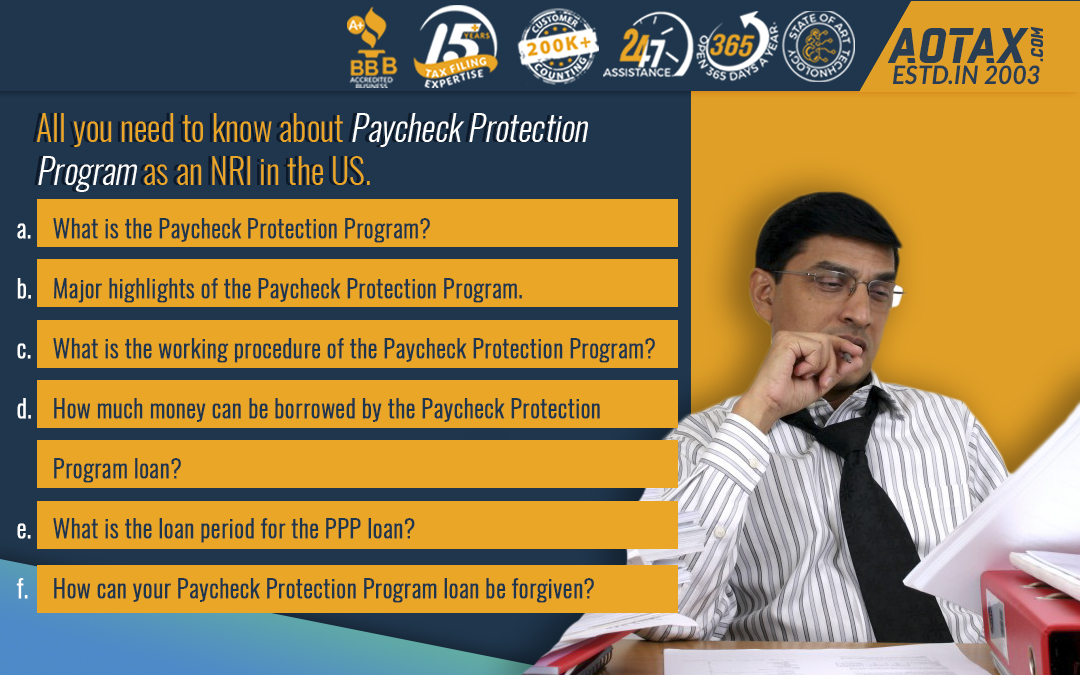All you need to know about Paycheck Protection
Program as an NRI in the US.

What is the Paycheck Protection Program?
The Paycheck Protection Program is a type of loan which has been created for helping businesses in the maintenance of their workforces during these adverse pandemic times. All types of loans taken by the business would be forgiven by the US Small Business Association (SBA) if the major criteria of retention of employees are met and the funds are being utilized for those business expenses which are eligible.
The Paycheck Protection Program (PPP) was a program of $350 billion whose major intent is to provide the small businesses in America with cash flow assistance of 8 weeks through 100% federal loans. In late April 2020, the Paycheck Protection Program was expanded by an addition of $310 billion into the funding of this program. The deadline for applying for the Paycheck Protection Program has expired since 8th August 2020 but there can be an extension if there is another relief bill that is signed into law.
Major highlights of the Paycheck Protection Program.
- The Paycheck Protection Program loans would have an interest rate of 1%.
- The benefits of the Paycheck Protection Program can be availed by all the small businesses of America.
- No personal guarantees or collateral are needed for those businesses which are availing of this program.
- The Paycheck Protection Program loan has a maturity rate of 2 years and an interest rate of around 1%.
- No fees would be charged from the small businesses either by the Government or by the lenders who are availing of this loan.
What is the working procedure of the Paycheck Protection Program?
Small businesses that have around 500 employees or even fewer employees, other independent contractors, sole proprietors, or those NRIs who are self-employed are eligible for availing the benefits of the Paycheck Protection Program.
- Sole proprietors would need to submit Schedule C from their tax returns filed which would provide details of the net profit that has been obtained from the proprietorship.
- Those NRIs who are independent contractors must submit Form 1099-MISC along with the Schedule C.
- The NRIs who are self-employed need to submit their payroll tax filings which have been reported to the IRS.
The Paycheck Protection Program loan would be completely forgiven if the fund from the loan would be utilized for interest on mortgages, payroll costs, utilities, and rent as well. There is no necessity for making the loan payment until the forgiveness application of the NRI has been processed or 10 months after the covered period of the loan ends.
How much money can be borrowed by the Paycheck Protection Program loan?
- In case of being a small business, you would be eligible to receive a loan which would be up to 2.5 times the average monthly payroll costs for the previous year.
- In the case of the NRI being self-employed or a sole proprietor, the loan amount that can be obtained is mainly calculated based on the payroll cost of the proprietor incurred in the last year. The full amount is up to $100,000 which can be the maximum limit that can be claimed by the small businesses.
What is the loan period for the PPP loan?
The loan period is for 8 weeks from the date of loan origination. This is the actual date on which the NRI borrower would receive the loan amount in actual. The interest payments on the Paycheck Protection Program loan will be deferred by around six months. This loan is due in two years and no penalty is charged for pre-paying the charges. However, the loan period has been extended to around 24 weeks.
How can your Paycheck Protection Program loan be forgiven?
By loan forgiveness, the loan can be turned into a non-taxable grant. The entire loan or a part of the loan which would be received by small businesses under the Paycheck Protection Program can be forgiven if the owner would keep all the full-time employees on their payroll or if you are re-hiring your employees again within 24 weeks of receipt of the loan.
For the loan amount to be forgiven a minimum of 60% of your loan should be utilized in funding the business payroll and the employee benefit costs as well. Only 40% of the amount that has been forgiven could be used for the non-payroll expenses like the payments of mortgage interest, payments of rents, utilities, etc. Forgiveness will not occur until the end of the 24-week employment period occurs after the loan amount has been received. Businesses must ensure that they must keep proper records and have proper bookkeeping as proof of the business expenses that have been incurred during the loan tenure.
Conclusion
So, the Paycheck Protection Program would be of great help for those who have incurred losses in business due to the pandemic and these coronavirus relief plans are evolving at a constant pace.

Recent Comments